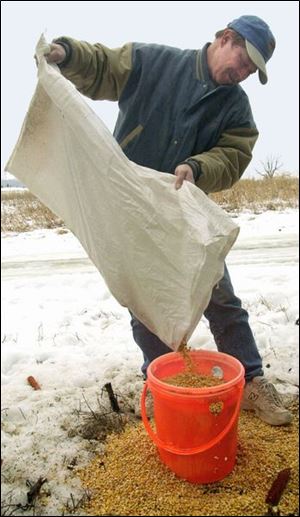
Helping pheasants flourish has rewards
1/31/2001
Terry McNalley, the president of Pheasants Forever, pours corn for the birds into a feeder that's near his home in Edgerton.
EDGERTON, Ohio - The short, sleek bird pecked around a sunflower patch, picking up the last of the seeds and grabbing any blades of wet grass peaking through the melting snow.
But the newly found smorgasbord of food hasn't been available to Ohio's pheasants during one of the harshest winters in recent history.
So, in an attempt to help their feathered friends flourish during the icy winter weather, members of the Williams County chapter of Pheasants Forever have made it their business to feed the birds.
“The way the weather came - first snow, then ice, then more snow - the birds couldn't get through to get to the food,” said Terry McNalley, 54, president of the local chapter. “That's why we started feeding them. That's not normally what we do.”
Many of the 370 local members of the national organization plant food plots around the county to help feed wildlife during winter. This year, the group took to spreading corn feed so that the land fowl could keep their bellies full even when they couldn't peck through the icy snow.
Natives of Asia, pheasants were first introduced to North American around the turn of the 20th century, said Chris Baker, a founding member of the Williams County chapter. Since then, they have flourished in cooler climates.
But harsh winters and steamy summers make it difficult for pheasants to maintain a strong population.
Pheasants Forever formed nationally in 1982 in response to the continuing decline of the ring-necked pheasant population. The nonprofit conservation organization has grown to include 55,000 members in 40 chapters throughout the country.
In Williams County, the group has spent nearly $126,000 on food since inception and about $3,300 for corn feed during this winter. And that doesn't include the hundreds of volunteer hours that go into spreading the feed and planting the food plots, Mr. Baker said.
Statewide the group has planted more than 56,000 acres of food plots for pheasants and wildlife over the last 15 years. The organization also offers youth programming and hunting education.
“People see that we're trying to make a difference,” Mr. Baker said. “Like we say, pheasants don't come out of a bank vault, they need to eat grass and food.”
Chapter members believe that the pheasant population has grown in Williams County nearly 10 times over the last decade or so. And thanks to efforts like the winter-feeding program, the local pheasant population keeps growing, Mr. Baker added.
Many county residents, whether chapter members or not, participated in the program by picking up feed at a local granary. Pheasants Forever, would then pick up the bill, said Dianna Kellogg, store manager for Edon Farmers Co-Op.
“When it first started, the members were coming to pick up feed. But then it got cold and icy, and they decided that anybody that wants to feed the birds and animals that are starving could come in and pick up food,” she said. “The people of Williams County really took to this.”
Ms. Kellogg said participants picked up close to 60,000 pounds of feed.
Although many of the Pheasant Forever members also hunt the birds, the winter-feeding is not to attract pheasants to a specific “hunting” area. Instead, feeding the birds ensures plentiful wildlife for the whole county. Rabbits, deer, and other species of birds also find the corn an appetizing discovery during winter, Mr. McNalley said.
Mr. McNalley said about 40 percent of the male pheasant population is killed during the December hunting season. Twenty percent die of natural causes. The females, which cannot be hunted, often die during the summer months because of heat and exhaustion after hatching their eggs.
But a well-fed hen is more likely to lay a larger number of eggs. So, chapter members plant and replenish food lots and build pheasant feeders to distribute corn, said chapter member and past president Van Hug, 42. “Measuring all the work that goes into it, you wouldn't believe that we just do it for fun,” he said.